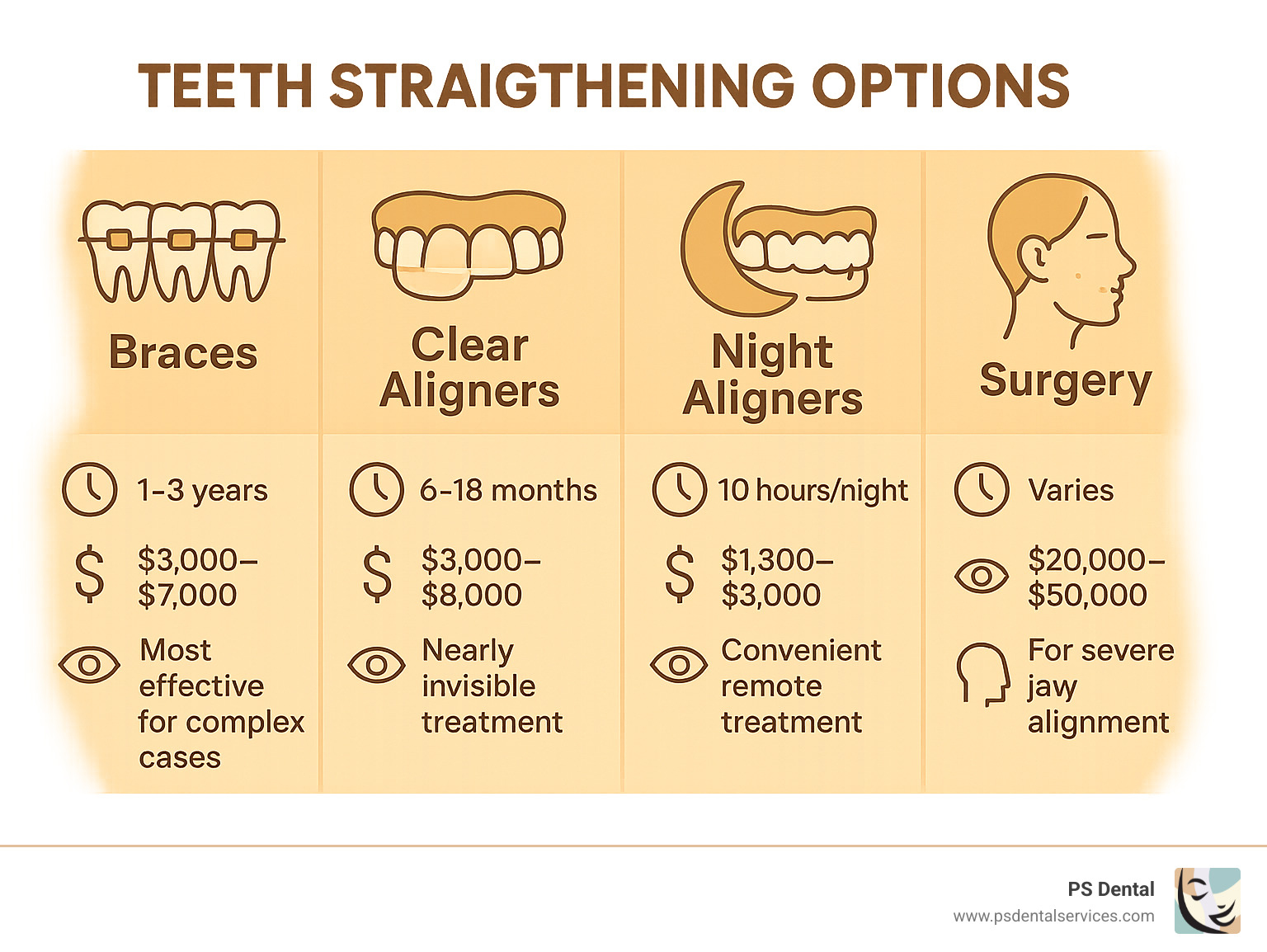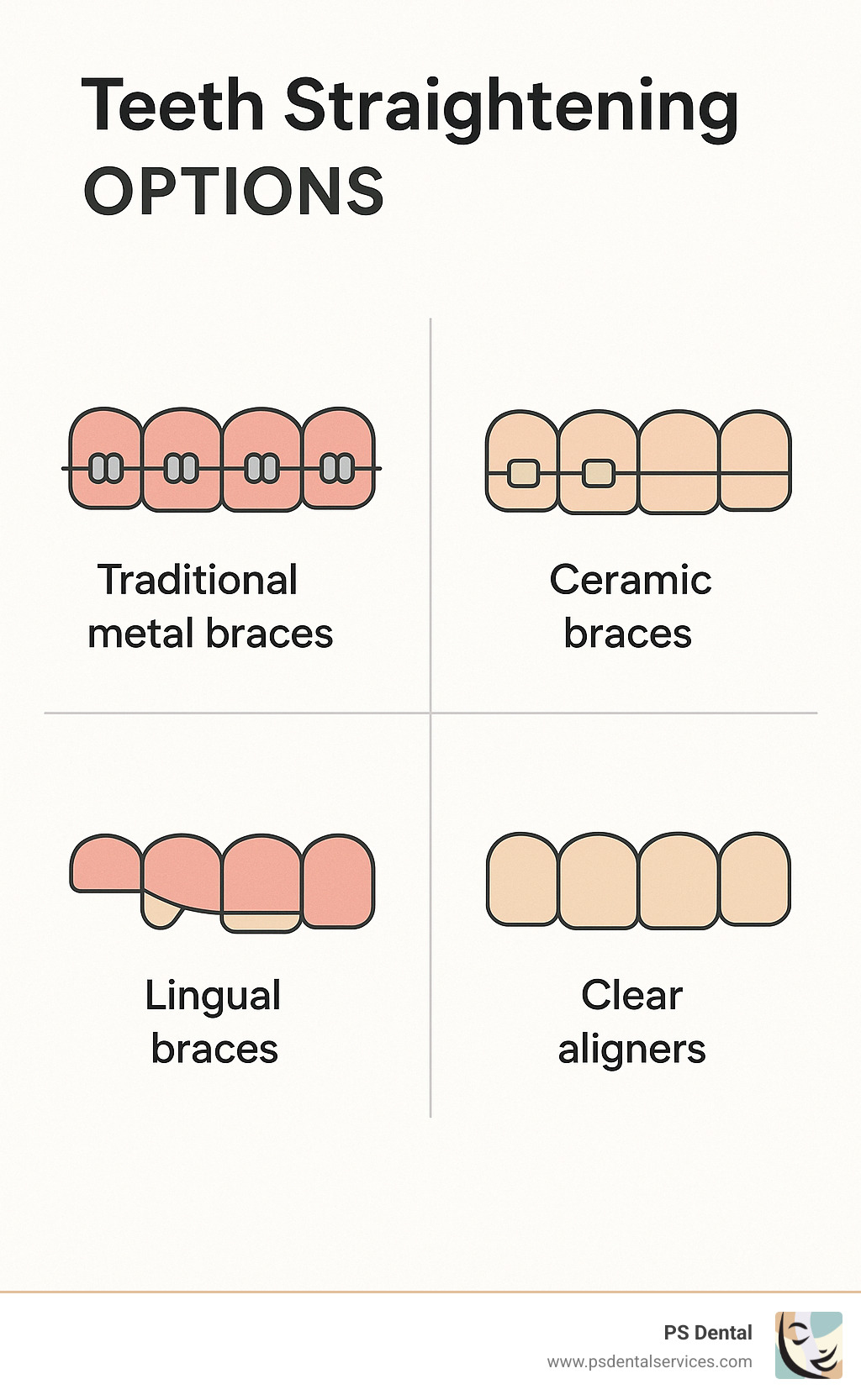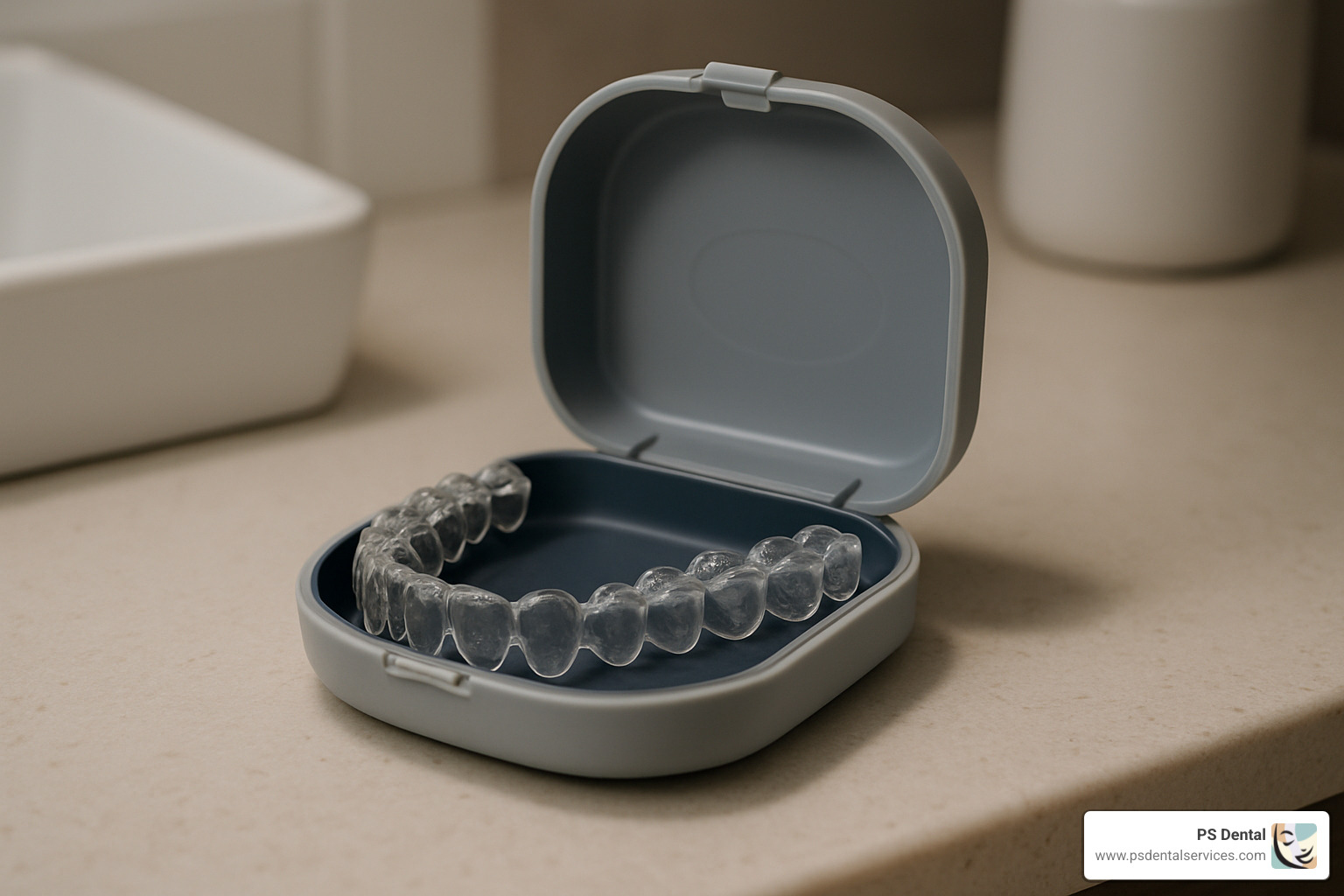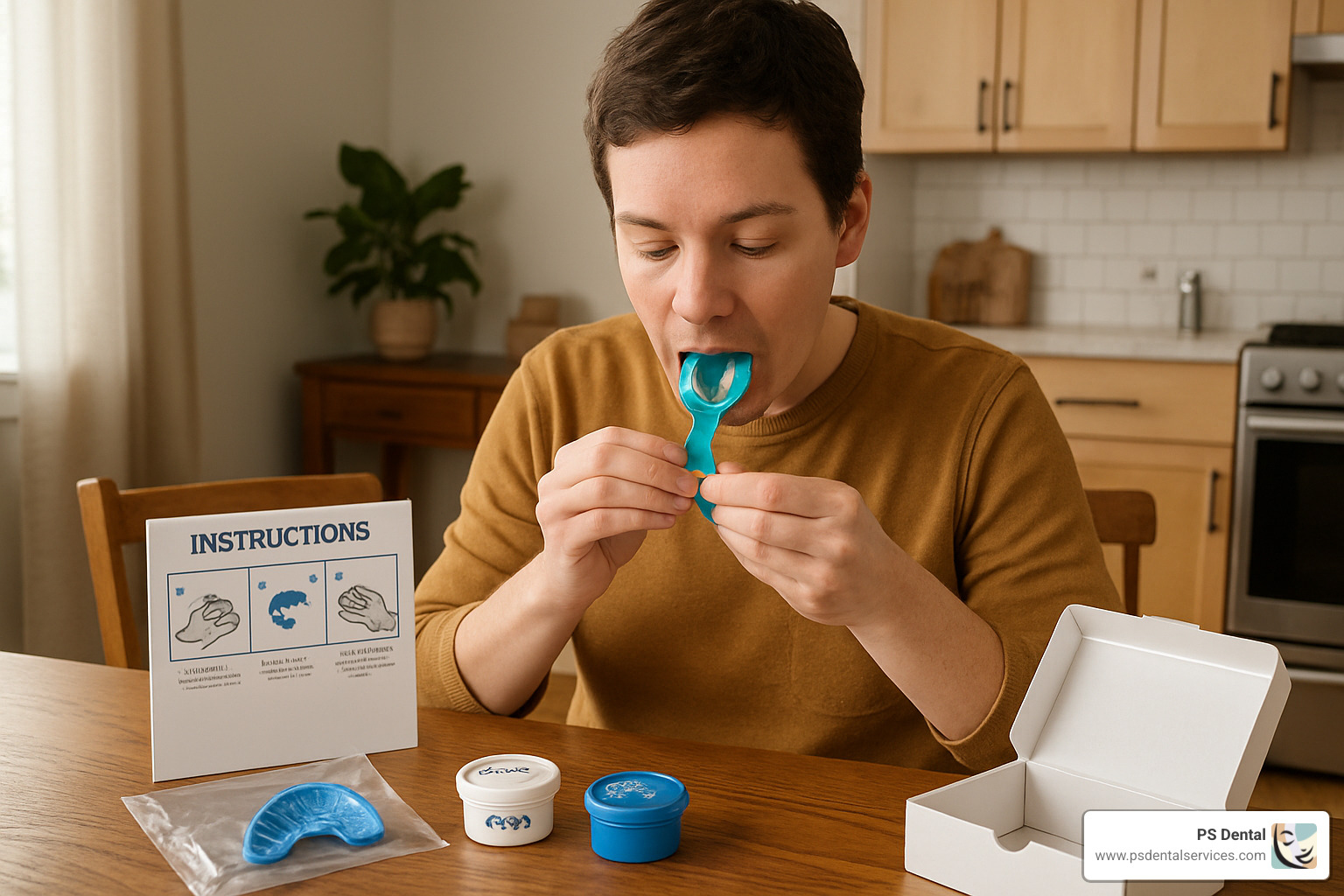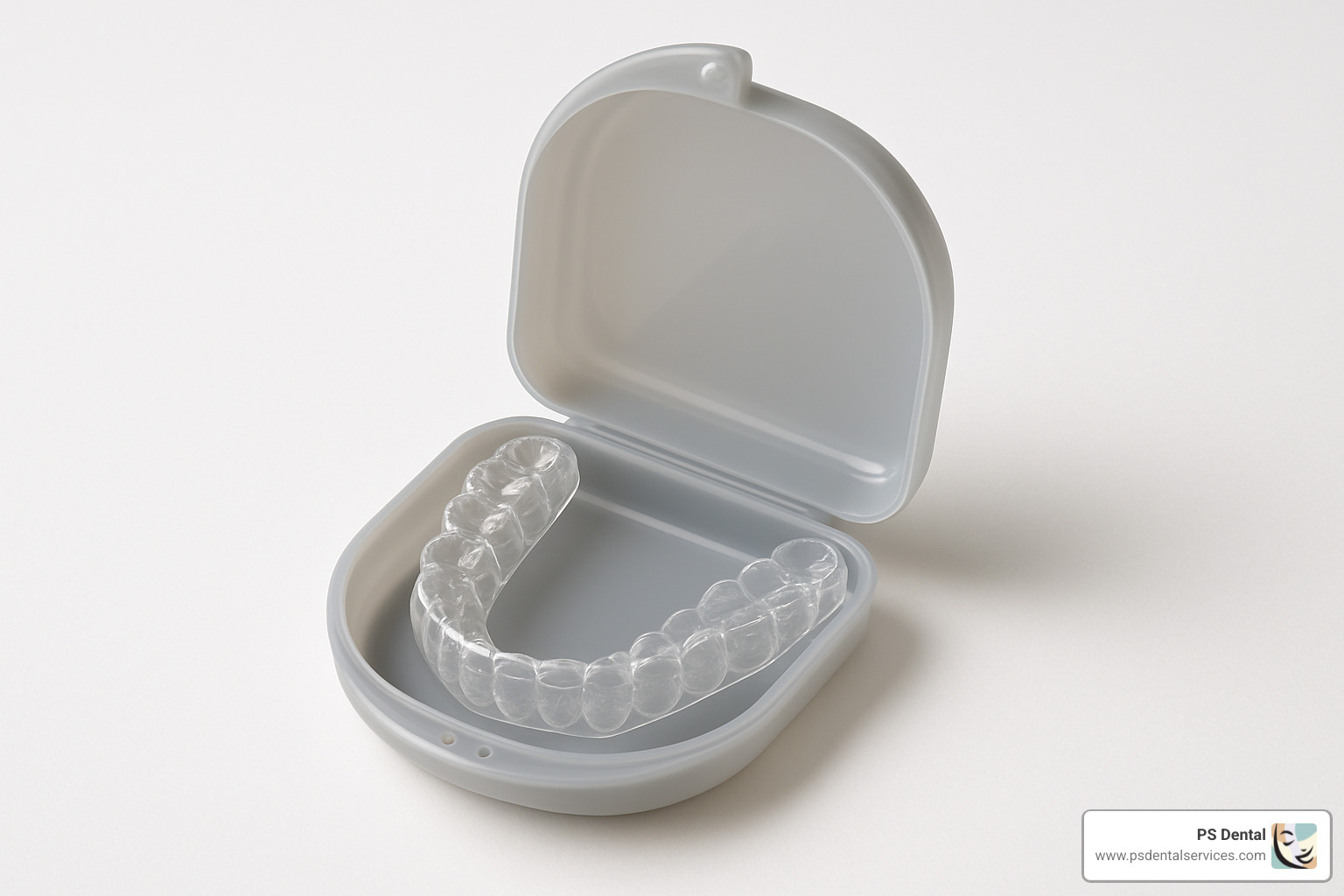Why Understanding Your Teeth Straightening Options Matters
Teeth straightening has become incredibly popular, especially as remote work puts our smiles front and center during video calls. If you’re looking for the best way to straighten your teeth, here are your main options:
Most Common Teeth Straightening Methods:
– Traditional Metal Braces – $3,000-$7,000, most effective for complex cases
– Clear Aligners (In-Office) – $3,000-$8,000, nearly invisible treatment
– At-Home Clear Aligners – $1,800-$3,000, convenient remote treatment
– Night Aligners – Wear only 10 hours while sleeping
– Ceramic/Lingual Braces – Less visible alternatives to metal braces
– Orthognathic Surgery – For severe jaw alignment issues
The rise of adult orthodontics has been dramatic – 80% of UK orthodontists reported more adults seeking treatment after the shift to remote work made people more aware of their smiles on camera.
Straight teeth offer benefits beyond looks. They’re easier to clean, reduce your risk of gum disease and tooth decay, and can improve digestion by helping you chew more effectively.
Treatment typically takes 4-6 months for at-home aligners and up to 18-24 months for traditional braces, depending on your case complexity.
I’m Dr. Parisa Sepehri, and I’ve been helping families achieve healthy, confident smiles for over 30 years through personalized teeth straightening treatments at my practice in Tigard.
Learn more about teeth straightening:
– Affordable clear aligners
– Clear aligners for kids
Health & Confidence Benefits of Straight Teeth
Most people think about teeth straightening because they want a prettier smile. But the health benefits are actually more impressive than just looking good in photos.
Think about trying to clean a messy closet where everything’s jumbled together. That’s what it’s like brushing crooked teeth. When your teeth are crowded or twisted, your toothbrush can’t reach all the spots where bacteria hide.
Straight teeth are simply easier to keep clean. No more struggling to floss between overlapping teeth or wondering if you’re missing spots when you brush. Our patients often tell us they feel like they’re finally winning the battle against plaque.
Your speech gets clearer too. If you’ve ever felt self-conscious about a lisp or certain sounds that don’t come out quite right, misaligned teeth might be the culprit. Proper tooth alignment can make a huge difference in how clearly you communicate.
And here’s something you might not expect: better chewing means better digestion. When your bite is properly aligned, you can break down food more effectively.
Beyond Aesthetics: Whole-Body Impact
Teeth straightening benefits don’t stop at your mouth – they ripple through your whole body.
TMJ relief is huge for many patients. When your teeth don’t fit together properly, your jaw joints have to compensate. This can lead to chronic headaches, jaw pain, and neck tension. I’ve had patients who suffered from daily headaches for years, only to find relief after we corrected their bite alignment.
Digestive health improves when you can chew properly. Digestion starts in your mouth. If you can’t break down food effectively because of misaligned teeth, your stomach has to pick up the slack.
The reduction in cavities and gum disease isn’t just about avoiding dental bills. Scientific research on plaque and tartar shows that oral bacteria can enter your bloodstream and contribute to heart disease and diabetes complications.
What I love most is seeing the confidence change. Adults make up about 20% of orthodontic patients now, and many wish they’d done it sooner. You’re never too old to benefit from straighter teeth. We’ve successfully treated everyone from teenagers to patients in their 60s.
Teeth Straightening Options
Choosing the right teeth straightening method can feel overwhelming, but understanding each option helps you make the best decision for your situation.
Traditional metal braces are still the powerhouse of orthodontics. These use small brackets attached to each tooth, connected by wires that gently guide your teeth into position. They’re visible, but incredibly effective at handling even the most stubborn alignment issues.
Ceramic braces work like metal braces but use tooth-colored or clear brackets that blend with your natural teeth. They’re much less noticeable but can be more delicate and might pick up stains if you’re not careful with oral hygiene.
Lingual braces hide completely behind your teeth. Nobody will know you’re wearing them, making them popular with adults in professional settings. The downside is they can be trickier to clean and might cause a slight lisp initially.
Clear aligners have changed the game for adult orthodontics. These nearly invisible, removable trays slowly shift your teeth using calculated pressure. You can remove them for meals, meetings, or special occasions.
Night aligners are perfect for busy professionals. You wear them for 10 hours while you sleep, and they work while you rest. They’re ideal for mild cases and people who spend time speaking publicly or on video calls.
For severe cases involving jaw alignment issues, orthognathic surgery might be necessary, involving repositioning the jaw bones with both an orthodontist and oral surgeon.
Treatment timelines vary significantly. Simple cases might wrap up in 4-6 months with aligners, while complex issues could take 18-24 months with traditional braces.
Traditional Braces vs Clear Aligners
Both options can deliver beautiful results. The choice usually comes down to your lifestyle and priorities.
Visibility is often the first concern. Clear aligners are practically invisible, while traditional braces are definitely noticeable.
Convenience is where aligners shine. You can remove them for eating, so no food restrictions. With braces, certain foods are off-limits.
Maintenance differs significantly. With aligners, you brush and floss normally when they’re out. With braces, you’ll need new techniques and possibly a water flosser.
Comfort is subjective, but most patients find aligners gentler. No brackets rubbing against cheeks or wires poking sensitive spots.
Effectiveness depends on your case. For complex movements or severe bite issues, traditional braces often work faster. For mild to moderate cases, aligners can be just as effective.
Night Aligners – Straighten While You Sleep
You can actually straighten your teeth while you sleep! Night aligners are designed for people who want teeth straightening benefits without daytime interference.
The science is simple. Your teeth respond to consistent, gentle pressure over time. By wearing specially designed aligners for 10 consecutive hours each night, you give your teeth enough time to gradually shift.
These aligners use slightly stronger forces than regular aligners to compensate for shorter wear time. They’re still comfortable and safe – you’ll likely forget you’re wearing them after the first few nights.
Night aligners are perfect for professionals who give presentations, people frequently on camera, musicians who play wind instruments, or anyone who prefers not to deal with removing aligners throughout the day.
Ideal candidates have mild to moderate crowding or spacing issues. More complex bite problems typically need longer wear time of traditional aligners or constant pressure of braces.
Treatment typically takes 6-8 months, slightly longer than full-time aligners but much faster than traditional braces for similar cases.
At-Home Clear Aligners: Step-by-Step Process
At-home clear aligners have revolutionized teeth straightening by making treatment more convenient and affordable. Understanding how the process works helps you make smart decisions about your smile.
The journey starts when an impression kit arrives at your door. Inside, you’ll find alginate putty, mixing tools, impression trays in different sizes, and step-by-step instructions that are easy to follow.
After creating your impressions and shipping them back, skilled technicians create a precise 3D model of your teeth. This becomes the blueprint for your treatment plan. Many companies now provide a 3D preview showing exactly how your teeth will look after treatment.
Your custom aligners are manufactured using 3D printing technology and arrive in stages. You’ll receive several sets at once, each slightly different to gradually guide your teeth into position.
Remote monitoring has become sophisticated. Many companies offer app tracking that lets you take progress photos, communicate with dental professionals, and use AI to monitor tooth movement.
Some companies include a whitening bonus – professional teeth whitening gel you can use with your aligners for a brighter, straighter smile.
For our Tigard patients who want aligner convenience with professional guidance, we offer Invisalign Clear Aligners with my personal supervision throughout treatment.
Creating Accurate Dental Impressions
The success of your teeth straightening treatment depends on getting accurate dental impressions.
Alginate putty comes from brown seaweed and transforms from liquid to solid in about a minute. The mixing time is crucial – you typically have 30-60 seconds to blend the putty and position it before it sets.
Getting the tray fit right makes all the difference. The tray should feel snug but not uncomfortably tight. Too loose, and you won’t capture detail. Too tight, and you might distort the impression when removing it.
Great impressions have complete coverage of all teeth and gum lines, no air bubbles, proper material thickness, and clear surface details. Common mistakes include rushing the mixing process, using ill-fitting trays, or removing the impression too early.
Many companies offer live video support during the impression process and send multiple kits in case your first attempt doesn’t turn out perfectly.
At our Tigard practice, we use advanced digital scanning technology that eliminates traditional impressions entirely. Visit our orthodontics page to learn about our comprehensive approach.
Who Is (and Isn’t) a Good Candidate?
Not everyone is perfect for at-home aligners. Being honest about this saves time, money, and frustration.
Ideal candidates have mild to moderate crowding – 2 or 3 teeth that are slightly rotated or overlapping. Spacing issues like small gaps respond beautifully. Minor bite issues can often be addressed, though complex bite problems need professional attention.
Age requirements vary, but most companies want you to be at least 18. Some accept patients as young as 16 with parental consent, but teeth and jaw should be fully developed.
Pregnancy considerations are important. While aligners won’t harm you or your baby, pregnancy hormones can make gums sensitive and cause teeth to shift. Most orthodontists recommend waiting until after pregnancy and breastfeeding.
At-home aligners have clear limitations. Severe crowding where teeth significantly overlap, major bite problems, and teeth needing more than 20 degrees of rotation typically require professional treatment.
If you have active gum disease, tooth decay, or missing teeth, these need addressing first. A history of jaw problems or TMJ disorders also puts you in the professional treatment category.
Safety, Costs & Insurance Snapshot
Safety should be your top priority when considering teeth straightening options. While at-home aligners use FDA-approved materials and many are licensed by Health Canada, the lack of professional supervision carries inherent risks.
FDA-approved materials ensure that aligners are made from safe, medical-grade plastics that won’t harm your teeth or gums. However, material safety is just one aspect of treatment safety.
Risks of DIY treatment include:
– Misfitting aligners that could damage teeth or gums
– Undetected oral health issues that worsen during treatment
– Inappropriate treatment plans that don’t address underlying problems
– Lack of professional monitoring to catch problems early
– Potential for irreversible damage if treatment goes wrong
Professional monitoring is crucial. Even with at-home aligners, periodic check-ups can catch problems before they become serious. Some companies now require virtual check-ins with licensed dentists, which is a positive development.
Cost comparison shows significant differences between treatment options:
– Metal braces: $3,000-$7,000
– Ceramic braces: $4,000-$8,500
– Lingual braces: $8,000-$13,000
– In-office clear aligners: $3,000-$8,000
– At-home clear aligners: $1,800-$3,000
Insurance coverage varies widely. Many plans cover up to $3,000 of orthodontic care, including clear aligners. However, coverage for at-home aligners is less consistent than for traditional orthodontic treatment.
HSA and FSA funds can often be used for orthodontic treatment, including clear aligners. Check with your plan administrator to confirm eligibility.
Financing options are available for most treatment types. Many orthodontic practices offer payment plans, and some aligner companies provide 0% APR financing for qualified patients.
For detailed information about dental impressions and what to expect, refer to this scientific research on dental impressions.
Life After Teeth Straightening: Retainers & Long-Term Maintenance
The day you finish your teeth straightening treatment is exciting, but it’s really just the beginning of maintaining your beautiful new smile. Think of it like losing weight – the hard work doesn’t end when you reach your goal. Your teeth have a memory, and without proper maintenance, they’ll try to drift back to their old positions.
This is where retainers become your best friend. Removable clear retainers look just like the aligners you might have worn during treatment – they’re nearly invisible and comfortable to wear. Hawley retainers are the traditional option with a wire across the front and colorful acrylic backing. They’re incredibly durable and can last for years with proper care. Fixed retainers are thin wires that we bond permanently to the back of your teeth, usually your front teeth where movement is most noticeable.
The wear schedule for retainers is crucial for success. Most patients start by wearing their retainers full-time (except when eating) for the first few months after treatment. This gives your teeth time to settle into their new positions. After this initial period, most people transition to nighttime-only wear, though some cases may require longer daytime wear.
Here’s something many patients don’t realize: relapse prevention is a lifelong commitment. Your teeth are held in place by tiny fibers called periodontal ligaments, and these need time to reorganize and strengthen in their new positions. Without retainers, even teeth that have been straight for years can start to shift.
Your oral hygiene routine actually becomes easier after teeth straightening, but it’s more important than ever. Those perfectly aligned teeth are much easier to brush and floss effectively, which means you can keep them healthier with less effort. Brush twice daily with fluoride toothpaste, floss every day, and don’t skip your regular dental cleanings.
Diet considerations are pretty straightforward but worth mentioning. Hard foods like ice or hard candy can crack retainers, while sticky foods like caramel can damage them or pull them off your teeth. Sugary drinks can cause problems too, especially if you’re sipping them while wearing retainers. When in doubt, remove your retainers before eating or drinking anything other than water.
If you play sports, custom-fitted mouthguards are essential for protecting your investment. A good mouthguard not only protects your teeth from injury but also prevents damage to your retainers if you wear them during activities.
Many parents ask us about maintenance for younger patients. We offer specialized Clear Aligners for Kids that take into account the unique challenges of growing smiles and changing habits.
The good news is that most of our patients find the maintenance phase much easier than the active treatment phase. Your retainers become part of your bedtime routine, just like brushing your teeth. And seeing your straight, healthy smile in the mirror every day makes it all worthwhile.
Frequently Asked Questions about Teeth Straightening
When I meet with patients at our Tigard practice, the same questions come up again and again about teeth straightening. Let me share the answers to the most common concerns I hear.
How long does treatment usually take?
This is probably the first question every patient asks, and honestly, it depends on several factors. Your treatment timeline will vary based on which method you choose and how complex your case is.
At-home clear aligners typically work fastest for mild cases, usually taking 4-6 months. This makes them appealing for adults who want quick results without frequent office visits.
Traditional braces generally require 18-24 months on average. While this seems long, they’re often the most efficient option for complex cases involving severe crowding or significant bite issues.
In-office clear aligners fall somewhere in between, usually taking 6-18 months depending on your specific needs. The professional monitoring can actually speed up treatment compared to at-home options.
Night aligners typically require 6-8 months, which is slightly longer than traditional aligners since you’re only wearing them 10 hours per day instead of 20-22 hours.
Several factors affect how quickly your teeth move. Your age plays a role – younger patients often see faster results because their bones are still developing. How well you follow instructions matters tremendously too. Patients who wear their aligners as directed and keep all their appointments almost always finish on schedule.
Your individual biology is unique. Some people’s teeth move quickly, while others take longer to respond to orthodontic forces. This isn’t something you can control, but it’s why regular check-ups are so important.
Are at-home impression kits safe and accurate?
I get asked this question a lot, especially by patients who are tempted by the convenience and lower cost of at-home options. The honest answer is that at-home impression kits can be safe and reasonably accurate when used properly, but they do have significant limitations.
The alginate material used in these kits is the same substance we use in dental offices, so the material itself isn’t the issue. The process is also fairly straightforward for most people if they follow the instructions carefully.
However, there are important differences between at-home impressions and what we can achieve professionally. When we take impressions in our office, we can ensure complete coverage of all your teeth and gum lines. We can immediately spot problems like air bubbles or distorted areas and retake the impression right away.
Digital scanning technology has revolutionized how we capture tooth impressions. These scanners create incredibly precise 3D models of your teeth without any messy materials. The accuracy is superior to traditional impressions, and there’s no waiting for materials to set or worrying about technique.
Professional settings also provide better lighting, positioning, and immediate quality control. If something doesn’t look right, we can address it immediately rather than finding the problem weeks later when your aligners don’t fit properly.
If you do choose at-home impressions, take your time with the process. Don’t rush the mixing – you typically have 30-60 seconds to get everything right. Make sure your impression trays fit properly, and don’t hesitate to request a replacement kit if you’re not satisfied with your first attempt.
Can I use my insurance or HSA/FSA to pay for clear aligners?
This question comes up in almost every consultation, and I understand why – orthodontic treatment is a significant investment. The good news is that many patients can use insurance or tax-advantaged accounts to help cover the costs.
Most dental insurance plans include orthodontic coverage with a lifetime maximum benefit, often around $3,000. This applies to teeth straightening treatment regardless of whether you choose braces or clear aligners. However, coverage varies significantly between different insurance companies and specific plans.
The key is understanding your specific benefits before starting treatment. Some plans require pre-authorization, while others have age restrictions or waiting periods. We’re happy to help verify your benefits and estimate your out-of-pocket costs.
HSA and FSA funds can typically be used for orthodontic treatment because it’s considered a qualified medical expense. This can provide significant tax savings, especially if you’re in a higher tax bracket. You’ll need to keep detailed receipts and may need a letter explaining the medical necessity of treatment.
Here are some practical tips for maximizing your coverage: Check your plan details before starting any treatment, not after. Get pre-authorization if your plan requires it – this prevents surprises later. Keep organized records of all treatment-related expenses, including consultation fees, x-rays, and follow-up visits.
Consider the timing of your treatment carefully. If you’re starting treatment near the end of the year, you might want to coordinate with your FSA contributions to maximize tax advantages.
Some at-home aligner companies don’t work directly with insurance, but you can often submit claims for reimbursement. The process takes longer, but you can still benefit from your coverage.
At PS Dental Services, we work with most major insurance plans and can help you understand your benefits. We also offer flexible payment options to make teeth straightening more accessible for our Tigard families.
Conclusion
Choosing the right teeth straightening option can feel overwhelming with so many choices available today. The good news? There’s never been a better time to achieve the smile you’ve always wanted, whether through traditional braces, clear aligners, or the newer night aligner options.
What matters most is finding a solution that fits your lifestyle, budget, and specific dental needs. Some patients thrive with the convenience of at-home aligners, while others benefit from the precision and professional monitoring that comes with in-office treatment.
At PS Dental Services here in Tigard, we’ve spent over 30 years helping families steer these decisions. Dr. Sepehri takes the time to understand not just your dental needs, but how orthodontic treatment will fit into your daily life. Whether you’re a busy professional who needs discreet treatment or a parent exploring options for your teenager, we believe in finding solutions that work for your whole family.
Teeth straightening is truly an investment in your future health and happiness. Yes, you’ll love how your smile looks, but the benefits go so much deeper. Easier cleaning, better digestion, reduced jaw pain, and the confidence that comes with a healthy smile – these advantages last a lifetime.
We know that every smile is unique, which is why cookie-cutter approaches don’t work. What’s perfect for your neighbor might not be right for you, and that’s exactly why professional guidance makes such a difference. We can help you weigh the pros and cons of each option and choose the path that makes the most sense for your situation.
Ready to take the next step? We’d love to meet with you and discuss your orthodontic treatment options in person. There’s something special about seeing the possibilities for your smile and having all your questions answered by someone who truly cares about your results.
Your smile tells your story to the world. Let’s make sure it’s a story you’re excited to share.
Dr. Parisa Sepehri
Latest posts by Dr. Parisa Sepehri (see all)
- Revolutionizing Tooth Restoration: The Future of Same Day CEREC Crowns - October 3, 2025
- Unlocking the Benefits of Hospital Dentistry: Emergency Care, Anesthesia, and Surgery for Special Needs Patients - October 2, 2025
- Revolutionizing Tooth Restoration: The Power of Same Day CAD/CAM Dental Technology for CEREC Crowns - October 1, 2025
- Unlock the Power of Prevention: The Benefits of Early Cavity Detection with a Family Dentist - September 30, 2025
- Revolutionizing Tooth Restoration: The Future of Same Day CEREC Crowns with CAD/CAM Dental Technology - September 29, 2025



